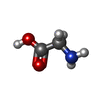[English] 日本語
 Yorodumi
Yorodumi- PDB-3ljq: Crystal Structure of the Glycosylasparaginase T152C apo-precursor -
+ Open data
Open data
- Basic information
Basic information
| Entry | Database: PDB / ID: 3ljq | ||||||
|---|---|---|---|---|---|---|---|
| Title | Crystal Structure of the Glycosylasparaginase T152C apo-precursor | ||||||
 Components Components | N(4)-(Beta-N-acetylglucosaminyl)-L-asparaginase | ||||||
 Keywords Keywords | HYDROLASE / Aspartylglucosylaminase / Active Precursors / Precursor structure / reversible inhibitor / constrained conformation / Autoproteolysis / catalytic mechanism / N-terminal nucleophile hydrolases | ||||||
| Function / homology |  Function and homology information Function and homology informationN4-(beta-N-acetylglucosaminyl)-L-asparaginase / N4-(beta-N-acetylglucosaminyl)-L-asparaginase activity / peptidase activity / periplasmic space / proteolysis / cytoplasm Similarity search - Function | ||||||
| Biological species |  Flavobacterium meningosepticum (bacteria) Flavobacterium meningosepticum (bacteria) | ||||||
| Method |  X-RAY DIFFRACTION / X-RAY DIFFRACTION /  SYNCHROTRON / SYNCHROTRON /  MOLECULAR REPLACEMENT / Resolution: 1.9 Å MOLECULAR REPLACEMENT / Resolution: 1.9 Å | ||||||
 Authors Authors | Wang, Y. / Guo, H.-C. | ||||||
 Citation Citation |  Journal: J.Mol.Biol. / Year: 2010 Journal: J.Mol.Biol. / Year: 2010Title: Crystallographic snapshot of glycosylasparaginase precursor poised for autoprocessing. Authors: Wang, Y. / Guo, H.C. | ||||||
| History |
|
- Structure visualization
Structure visualization
| Structure viewer | Molecule:  Molmil Molmil Jmol/JSmol Jmol/JSmol |
|---|
- Downloads & links
Downloads & links
- Download
Download
| PDBx/mmCIF format |  3ljq.cif.gz 3ljq.cif.gz | 131.7 KB | Display |  PDBx/mmCIF format PDBx/mmCIF format |
|---|---|---|---|---|
| PDB format |  pdb3ljq.ent.gz pdb3ljq.ent.gz | 100.8 KB | Display |  PDB format PDB format |
| PDBx/mmJSON format |  3ljq.json.gz 3ljq.json.gz | Tree view |  PDBx/mmJSON format PDBx/mmJSON format | |
| Others |  Other downloads Other downloads |
-Validation report
| Summary document |  3ljq_validation.pdf.gz 3ljq_validation.pdf.gz | 448 KB | Display |  wwPDB validaton report wwPDB validaton report |
|---|---|---|---|---|
| Full document |  3ljq_full_validation.pdf.gz 3ljq_full_validation.pdf.gz | 454.1 KB | Display | |
| Data in XML |  3ljq_validation.xml.gz 3ljq_validation.xml.gz | 27.6 KB | Display | |
| Data in CIF |  3ljq_validation.cif.gz 3ljq_validation.cif.gz | 40.9 KB | Display | |
| Arichive directory |  https://data.pdbj.org/pub/pdb/validation_reports/lj/3ljq https://data.pdbj.org/pub/pdb/validation_reports/lj/3ljq ftp://data.pdbj.org/pub/pdb/validation_reports/lj/3ljq ftp://data.pdbj.org/pub/pdb/validation_reports/lj/3ljq | HTTPS FTP |
-Related structure data
| Related structure data |  9gacS S: Starting model for refinement |
|---|---|
| Similar structure data |
- Links
Links
- Assembly
Assembly
| Deposited unit | 
| ||||||||
|---|---|---|---|---|---|---|---|---|---|
| 1 |
| ||||||||
| Unit cell |
|
- Components
Components
| #1: Protein | Mass: 32582.053 Da / Num. of mol.: 2 / Fragment: UNP residues 46-340 / Mutation: T152C Source method: isolated from a genetically manipulated source Source: (gene. exp.)  Flavobacterium meningosepticum (bacteria) Flavobacterium meningosepticum (bacteria)Gene: GA(1-295) / Plasmid: pMAL-c2x / Production host:  References: UniProt: Q47898, N4-(beta-N-acetylglucosaminyl)-L-asparaginase #2: Chemical | #3: Chemical | ChemComp-GLY / | #4: Water | ChemComp-HOH / | |
|---|
-Experimental details
-Experiment
| Experiment | Method:  X-RAY DIFFRACTION / Number of used crystals: 1 X-RAY DIFFRACTION / Number of used crystals: 1 |
|---|
- Sample preparation
Sample preparation
| Crystal | Density Matthews: 2.2 Å3/Da / Density % sol: 43.99 % |
|---|---|
| Crystal grow | Temperature: 277 K / pH: 7.5 Details: 15% PEG 3350, 100 mM HEPES pH 7.5, 0.1% sodium azide, VAPOR DIFFUSION, HANGING DROP, temperature 277K |
-Data collection
| Diffraction | Mean temperature: 100 K |
|---|---|
| Diffraction source | Source:  SYNCHROTRON / Site: SYNCHROTRON / Site:  NSLS NSLS  / Beamline: X12C / Wavelength: 1.10005 / Beamline: X12C / Wavelength: 1.10005 |
| Radiation | Protocol: SINGLE WAVELENGTH / Monochromatic (M) / Laue (L): M / Scattering type: x-ray |
| Radiation wavelength | Wavelength: 1.10005 Å / Relative weight: 1 |
| Reflection | Resolution: 1.9→31.74 Å / Num. obs: 42606 / % possible obs: 97.2 % / Observed criterion σ(I): 2 / Redundancy: 2 % / Rmerge(I) obs: 0.029 / Rsym value: 0.029 / Net I/σ(I): 26.7 |
| Reflection shell | Resolution: 1.9→1.97 Å / Rmerge(I) obs: 0.059 / Mean I/σ(I) obs: 13.3 / Rsym value: 0.059 |
- Processing
Processing
| Software |
| ||||||||||||||||||||||||||||||||||||||||||||||||||||||||||||
|---|---|---|---|---|---|---|---|---|---|---|---|---|---|---|---|---|---|---|---|---|---|---|---|---|---|---|---|---|---|---|---|---|---|---|---|---|---|---|---|---|---|---|---|---|---|---|---|---|---|---|---|---|---|---|---|---|---|---|---|---|---|
| Refinement | Method to determine structure:  MOLECULAR REPLACEMENT MOLECULAR REPLACEMENTStarting model: PDB ENTRY 9GAC Resolution: 1.9→31.74 Å / Cross valid method: THROUGHOUT / σ(F): 2 / Stereochemistry target values: ENGH & HUBER
| ||||||||||||||||||||||||||||||||||||||||||||||||||||||||||||
| Refinement step | Cycle: LAST / Resolution: 1.9→31.74 Å
| ||||||||||||||||||||||||||||||||||||||||||||||||||||||||||||
| Refine LS restraints |
|
 Movie
Movie Controller
Controller



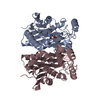


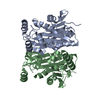
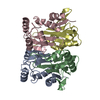

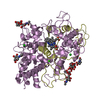






 PDBj
PDBj








